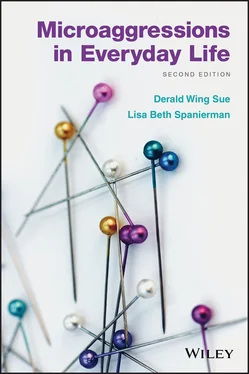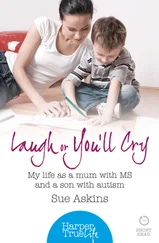The Way Forward: Dealing with Psychological Dilemmas
Section Two—Microaggressive Impact on Targets and Perpetratorsis composed of three chapters. In this section, we provide a model to understand the internal struggle of microaggression recipients, and the harm it has on their physical and mental well‐being. Quite new is our chapter on microaggressive perpetrators and the unique analysis of the impact that microaggressions have upon them.
Chapter 4—The Microaggression Process Model: The Internal Struggle of Targets
Tracing the Impact of MicroaggressionsPhase One—The Potential Microaggressive Incident or EventPhase Two—Initial Assessment and Questioning of the IncidentPhase Three—Reaction ProcessesPhase Four—Interpretation and MeaningPhase Five—Consequences and Impact
The Microaggression Process Model: Recap
The Way Forward: Strength through Adversity
Chapter 5—Microaggressive Stress: Impact on Physical and Psychological Well‐Being
Biological Stressors: A Roadmap to Understanding Microaggressive Harm
Psychological and Social StressorsMicroaggressions and Daily HasslesImpact of Everyday HasslesThe Life‐Change Model of StressThe Transactional Model of StressSituating Stress in the Macro‐Context of Oppression
The Harmful Effects of Microaggressive StressPhysical Health Effects of Microaggressive StressorsPsychological Health Effects of Microaggressive Stressors
Strength through Adversity
The Way Forward: Responding Strategically and Resisting Microaggressions
Chapter 6—Microaggressive Perpetrators: Who, What, When, How, and Why?
Who Are Microaggressive Perpetrators?
How and Why Do Individuals Perpetrate Microaggressions?Using the Tools: Creating and Maintaining DominancePower to Impose a Biased Reality
What Makes It So Difficult for Perpetrators to Recognize Their Privilege?Layer One—Fear of Appearing BiasedLayer Two—Fear of Recognizing One's Complicity in OppressionLayer Three—Fear of Acknowledging One's PrivilegeLayer Four—Fear of Taking Personal Responsibility to End Oppression
What Are the Costs of Microaggressions to Perpetrators?Cognitive Costs of OppressionEmotional Costs of OppressionBehavioral Costs of OppressionSpiritual and Moral Costs of Oppression
The Way Forward: The Ethical Mandate
Section Three—Interrogating Microaggressions: On Research, Teaching, and Counselingis composed of three chapters. In this section, we discuss microaggressions from three different perspectives: (a) what has microaggression research revealed and how research methodologies can be used to study the phenomena, (b) how educators need to be cognizant of addressing and teaching about microaggressions, and (c) what mental health professionals need to address in their own personal awakening about microaggressions, and in the quality care of services delivered to culturally diverse clients.
Chapter 7—Researching Microaggressions: Show Me the Evidence!
In Their Own Words: Qualitative Investigation of MicroaggressionsPurposive SamplesFocus GroupsIndividual InterviewsOther Data SourcesTrustworthiness
Do Findings Generalize? Quantitative Investigation of MicroaggressionsMeasuring MicroaggressionsQuantitative Research Designs
Summary
The Way Forward: Future Research Directions
Chapter 8—Teaching About Microaggressions
Faculty Narratives: Facing Challenges in the ClassroomChallenges Faculty Members of Color FaceChallenges White Faculty Members Face
Encountering Microaggressions in the Classroom
Navigating Microaggressions: What Can Educators Do?
Microaggressions Pedagogy: How to Teach about Microaggressions
The Way Forward: General Strategies for Facilitating Difficult Dialogues on Race
Chapter 9—Microaggressions in Counseling and Psychotherapy
Underutilization of Mental Health Services
Premature Termination and Quality of Mental Health Care
Multicultural Counseling Competence
Manifestation of Racial Microaggressions in Counseling and Psychotherapy
Microaggressions Influence Counseling Process and OutcomesInnovative Research Approaches
The Way Forward: Microaggressions Implications for Practice and Research
Section Four—Disarming Microaggressions and Macroaggressionsis composed of one chapter. It is a fitting end to the book, because it directly addresses what targets, allies, and bystanders can do to disarm or neutralize microaggressions.
Chapter 10—Microintervention Strategies for Disarming Microaggressions and Macroaggressions
Microaggressions and Macroaggressions
The Need to Take Action: Targets, Allies, and BystandersTargetsAlliesBystanders
Responding to Microaggressions and Macroaggressions
MicrointerventionsStrategic Goal: Make the “Invisible” VisibleStrategic Goal: Disarm the MicroaggressionStrategic Goal: Educate the PerpetratorStrategic Goal: Seek External Intervention or Support
Microinterventions and Macroaggressions
Context Matters
The Way Forward: Microinterventions and the New Research Frontier
It is important to note that a major goal of the text is to present research data, theory, and practical suggestions on how to overcome microaggressions that target members of marginalized groups and to make specific suggestions related to how microaggressions can be ameliorated at individual, institutional, and societal levels. To further emphasize remedial and preventive interventions, we updated the special concluding sections in each chapter, “The Way Forward,” to provide guidelines, strategies, and interventions that readers can enact to reduce the frequency and impact of microaggressions in our society. We also devote an entire chapter ( Chapter 10) to offer readers a conceptual framework and specific microintervention tactics.
In closing, we would like to personally acknowledge our family and partners for their encouragement, support, and help throughout this project. Derald Wing Sue would like to dedicate this book to his wife, Paulina, his son Derald Paul and wife Claire, granddaughters Caroline and Juliette, his daughter Marissa Catherine and husband Neal, and grandsons Niam and Kiran. Lisa B. Spanierman would like to dedicate this book to Tony Clark for his unwavering support, her parents, Brenda and Ron, and her sister, Dana. She would also like to thank Jorge Ballesteros, Shelby Messerschmitt‐Coen, and Jackson Liguori for their helpful research assistance.
Derald Wing Sue
Lisa Beth Spanierman
July 2019
SECTION ONE Psychological Manifestation and Dynamics of Microaggressions
CHAPTER ONE Microaggressions as Toxic Rain: Here, There, and Everywhere!
“Still I Rise”
You may write me down in history
With your bitter, twisted lies,
You may tread me in the very dirt
But still, like dust, I'll rise.
..............................................
You may shoot me with your words,
You may cut me with your eyes,
You may kill me with your hatefulness,
But still, like air, I'll rise.
Maya Angelou
Written by Maya Angelou, a renowned African American poet, writer, and Civil Rights advocate, the poem “Still I Rise” both empowers and validates those who have suffered oppression, abuse, bullying, humiliation, and injustice and pricks the conscience of “oppressors” for the hurt and pain caused by their racial prejudice and discriminatory actions. It is also a testament to the courage, resilience, and strength of African Americans in their ability to survive and thrive in the face of constant hatred and bigotry. Although written primarily about the lived experience of Black individuals in the United States, the poem has universal appeal and application to all persons of color and to members of socially marginalized groups in our society.
Читать дальше












